
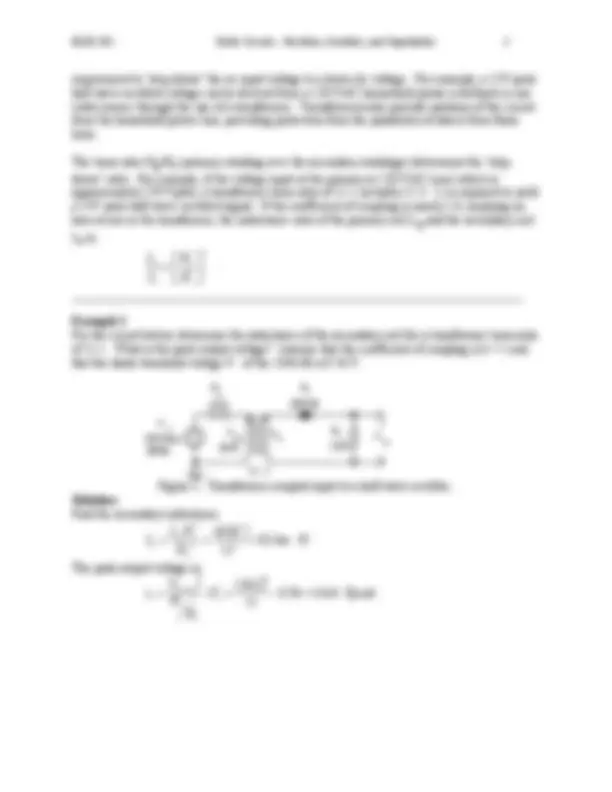
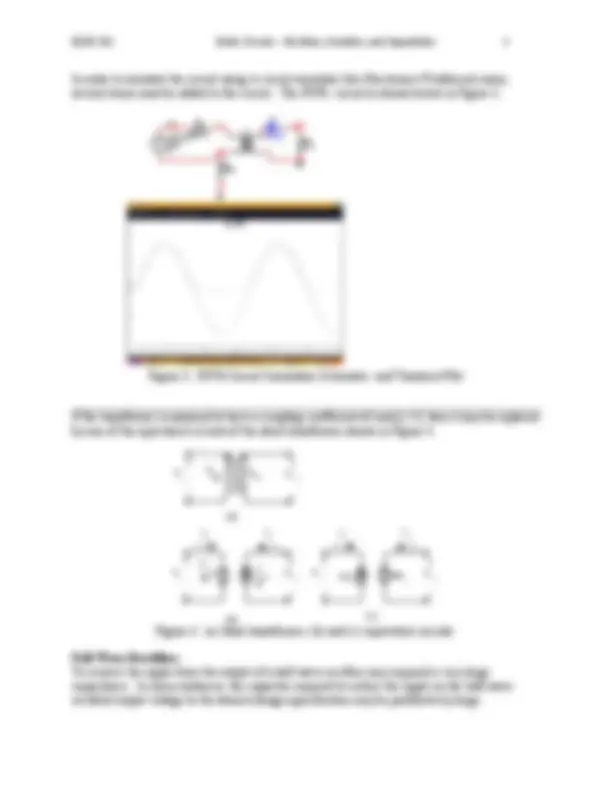
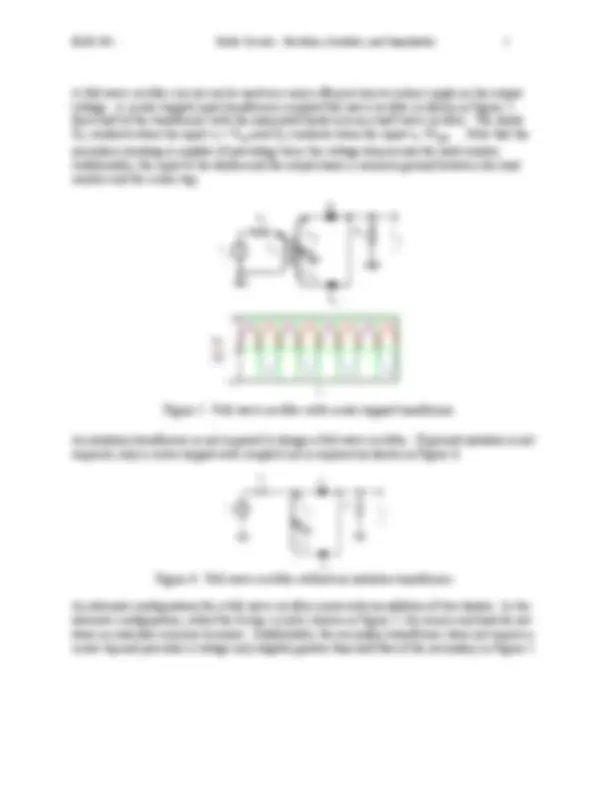
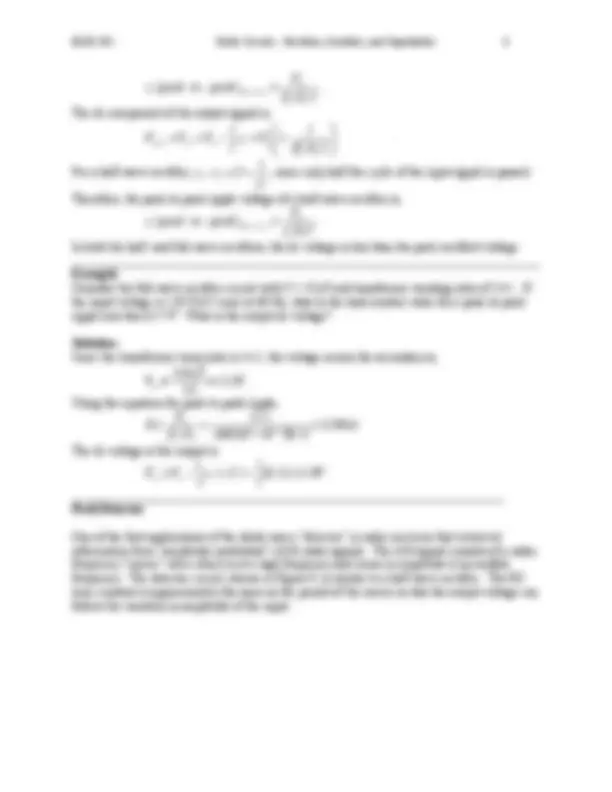
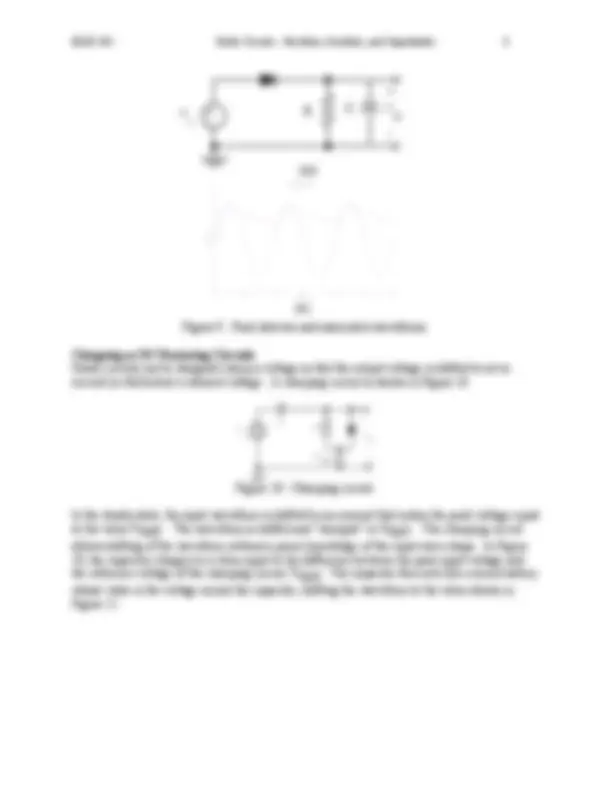
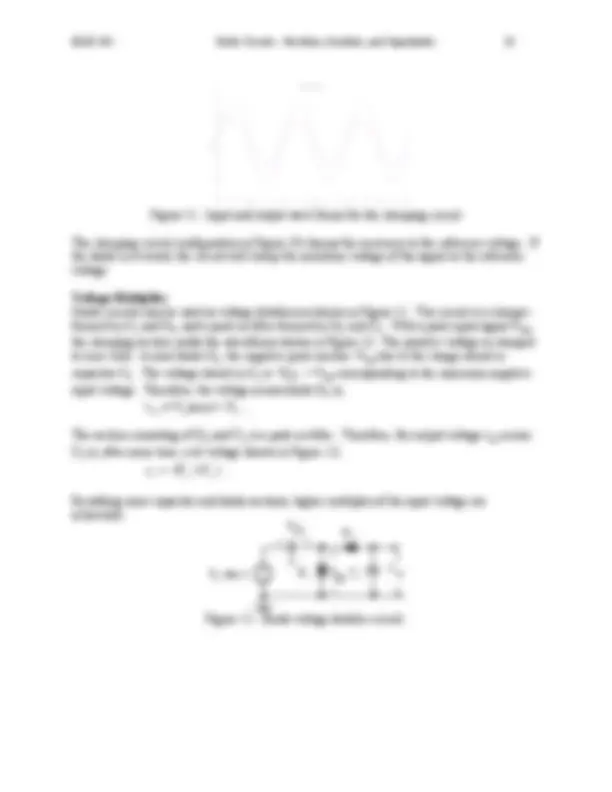


Study with the several resources on Docsity

Earn points by helping other students or get them with a premium plan


Prepare for your exams
Study with the several resources on Docsity

Earn points to download
Earn points by helping other students or get them with a premium plan
Community
Ask the community for help and clear up your study doubts
Discover the best universities in your country according to Docsity users
Free resources
Download our free guides on studying techniques, anxiety management strategies, and thesis advice from Docsity tutors
A comprehensive overview of diode circuits, focusing on rectifiers, doublers, and superdiodes. It delves into the principles of half-wave and full-wave rectification, explaining the operation of various circuits and their applications in power supply design. The document also explores clamping circuits, voltage multipliers, and the use of superdiodes in precision circuits. It includes detailed explanations, diagrams, and examples to illustrate the concepts.
Typology: Lecture notes
1 / 12

This page cannot be seen from the preview
Don't miss anything!







Half-Wave Rectifiers
One of the most common diode application is the conversion of power from ac to dc for use as
power supplies.
Figure 1. Half-wave rectifier with the output voltage waveform.
Figure 1 shows a half-wave rectifier circuit. The circuit is so named because it only allows
current from the positive half cycle of the input to flow through the load resistor, R.
If v i
is a sinusoidal voltage with peak voltage V m
and radian frequency,
i m
the average voltage V dc
across the load, R, is
T
0
dc (^) ò o
where T is the period of the sinusoid.
Since the diode is OFF in the interval
£ t £ T, output voltage is
t T.
v t V sin t-V t o m on
w , 0
Substituting Equation 2.6.2-2 into 2.6.2-1 to solve for V dc
0
2
0 2
t- 1
t
- cos t
V sin t V dt =
m on 2
T
on
T
2 m
T
0
dc m on
ò
But w
p
so the equation simplifies to
m on
dc
p
v
i^ -
v
o
0
Voi
Voxi
ti
v
i^ -
v
o
0
Voi
Voxi
ti
Recall that the "effective" or root-mean-squared (rms) voltage quantifies the amount of energy
delivered to a resistor in T seconds. The use of rms comes from the desire to compare the ability
of a sinusoid to deliver energy to a resistor with the ability of a dc source.
The rms value of any periodic waveform v o
(t) is defined as,
2
1
ú
û
ù
ê
ë
é
v tdt
T
0
rms o
The output rms voltage for the half-wave rectifier is
2
1
2 2
1
2 2
2
1
2
ú
ú
û
ù
ê
ê
ë
é
ú
û
ù
ê
ë
é
ú
û
ù
ê
ë
é
V sin t V V sin t+V dt
V sin t V dt
2
2 m on^ m
T
0
on m
2
m
2
T
0
rms m on
g
g
If V on
m
then the equation reduces to
sin
2
1
0
2
V t dt
m m 2
T
rms m
ú
û
ù
ê
ë
é
The efficiency of rectification is defined as
ac
dc
where P ac
and P dc
are ac and dc powers respectively. For the half-wave, the efficiency is
m
m
ac
dc 406
2 2
2
ø
ö
ç
è
æ
ø
ö
ç
è
æ
The result is for an ideal half-wave rectifier and represents the maximum efficiency attainable.
In real systems, the efficiency will be lower due to power losses in the resistor and diode.
In order to produce a dc voltage from a half-wave rectifier, a large capacitor is placed in parallel
to the load resistor. The capacitor must be large enough so that the RC time constant of the
capacitor and load resistor is large compared to the period of the output waveform. This has the
effect of "smoothing" the output waveform. Clearly, and efficient filter is required to eliminate
any ripple in the output waveform.
In many rectifier applications, it is desirable to transformer couple the input voltage source to the
rectifier circuit. This method is commonly used in the design of power supplies where there is a
In order to simulate the circuit using A circuit simulator like Electronics Workbench msim,
several items must be added to the circuit. The EWB circuit is shown below in Figure 3.
Figure 3. EWB Circuit Simulation Schematic and Transient Plot
If the transformer is assumed to have a coupling coefficient of nearly 1.0, then it may be replaced
by one of the equivalent circuits of the ideal transformer shown in Figure 4.
v
1
v
2
L
p
L
s
v (^) v
2
i
1
i
2
v
2
n
1
v
1
v
2
i
1
i
2
1 n i^ nv 2
i
1
n
(a)
(b)
(c)
Figure 4. (a) Ideal transformer; (b) and (c) equivalent circuits.
Full-Wave Rectifiers
To remove the ripple from the output of a half-wave rectifier may required a very large
capacitance. In many instances, the capacitor required to reduce the ripple on the half-wave
rectified output voltage to the desired design specification may be prohibitively large.
R
500mΩ
T
R
1MΩ
D
1N
1
R
1kΩ
V1 4 Vout
120 Vrms
60 Hz
0°
3
0
2 0
R
500mΩ
T
R
1MΩ
D
1N
1
R
1kΩ
V1 4 Vout
120 Vrms
60 Hz
0°
3
0
2 0
A full-wave rectifier circuit can be used as a more efficient way to reduce ripple on the output
voltage. A center-tapped input transformer-coupled full-wave rectifier is shown in Figure 5.
Each half of the transformer with the associated diode acts as a half-wave rectifier. The diode
conducts when the input v i
on
and D 2
conducts when the input v i
on
. Note that the
secondary winding is capable of providing twice the voltage drop across the load resistor.
Additionally, the input to the diodes and the output share a common ground between the load
resistor and the center-tap.
Figure 5. Full-wave rectifier with center-tapped transformer.
An isolation transformer is not required to design a full-wave rectifier. If ground isolation is not
required, only a center-tapped well coupled coil is required as shown in Figure 6.
R v
o
v
i
R
s
L
D
L s
L s
D
1
2
Figure 6. Full-wave rectifier without an isolation transformer.
An alternate configuration for a full-wave rectifier exists with an addition of two diodes. In the
alternate configuration, called the bridge rectifier shown in Figure 7 , the source and load do not
share an essential common terminal. Additionally, the secondary transformer does not require a
center tap and provides a voltage only slightly greater than half that of the secondary in Figure 5.
0
Vo i
Voxi
t i
R
v
i
v
o
R
s
L
D
L
p
L s
L s
D
1
2
0
Vo i
Voxi
t i
R
v
i
v
o
R
s
L
D
L
p
L s
L s
D
1
2
In order to produce a dc source from the output of a full-wave rectifier, a capacitor is placed in
parallel to the load resistor as shown in Figure 8. The RC time constant must be long with
respect to
to "smooth out" the output waveform.
Figure 8. Filtered full-wave rectifier circuit.
Figure 8. Full-wave rectified voltage with ripple.
Let t 1
and t 2
be the time between two adjacent peaks of the filtered rectified voltage as shown in
Figure 8. Then the output voltage between t 1
and t 2
is,
( )
1 2
R C
t- t
-
o m
v V e ,t t t
L
1
The peak-to-peak ripple is defined as,
( )
ø
ö
ç
ç
è
æ
R C
t t
-
r o 1 o 2 m
L
2 1
v v t v t V 1 e.
If R L
C >> (t 2
) then the exponential approximation can be used,
e » 1 - x,forx << 1
-x
.
A good approximation for the peak-to-peak ripple voltage is,
t t
v peak-to-peak V
L
2 1
r m
Since
0
2 1
2 f
t t
is the frequency of the input signal and T is the period of that
signal, the peak-to-peak ripple voltage for a full-wave rectifier circuit is,
R
v
i
v
o
R s
L
D
L
p
L
s
D
D^ D
C
1 2
4 3
2f RC
v peak-to- peak
o L
m
r full- wave
The dc component of the output signal is,
ø
ö
ç
ç
è
æ
4f RC
v =V 1 -
o L
O,dc dc m r m
For a half-wave rectifier,
0
2 1
f
t t T
Therefore, the peak-to-peak ripple voltage of a half-wave rectifier is,
f RC
v peak-to- peak
o L
m
r half- wave
In both the half- and full-wave rectifiers, the dc voltage is less than the peak rectified voltage.
Example
Consider the full-wave rectifier circuit with C = 47μF and transformer winding ratio of 14:1. If
the input voltage is 120 VAC (rms) at 60 Hz, what is the load resistor value for a peak-to-peak
ripple less than 0.5 V? What is the output dc voltage?
Solution:
Since the transformer turns ratio is 14:1, the voltage across the secondary is,
m
Using the equation for peak-to-peak ripple,
( )( )( )
6
k
2f Cv
o r
m
The dc voltage at the output is
V V v 12.1 - dc m r
Peak Detector
One of the first applications of the diode was a "detector" in radio receivers that retrieved
information from "amplitude modulated" (AM) radio signals. The AM signal consists of a radio-
frequency "carrier" wave which is at a high frequency and varies in amplitude at an audible
frequency. The detector circuit, shown in Figure 9 , is similar to a half-wave rectifier. The RC
time constant is approximately the same as the period of the carrier so that the output voltage can
follow the variation in amplitude of the input.
Figure 11. Input and output wave forms for the clamping circuit.
The clamping circuit configuration in Figure 10 clamps the maximum to the reference voltage. If
the diode is reversed, the circuit will clamp the minimum voltage of the signal to the reference
voltage.
Voltage Multiplier
Diode circuits may be used as voltage doublers as shown in Figure 12. The circuit is a clamper
formed by C 1
and D 1
, and a peak rectifier formed by D 1
and C 2
. With a peak input signal V m
the clamping section yields the waveforms shown in Figure 13. The positive voltage is clamped
to zero volts. Across diode D 1
, the negative peak reaches - V m
due to the charge stored in
capacitor C 1
. The voltage stored in C 1
is V C
m
corresponding to the maximum negative
input voltage. Therefore, the voltage across diode D 1
is,
v V sin t V D1 m C
The section consisting of D 2
and C 2
is a peak rectifier. Therefore, the output voltage v o
across
is, after some time, a dc voltage shown in Figure 13 ,
o m C
v = - V +V.
By adding more capacitor and diode sections, higher multiples of the input voltage are
achievable.
v
o
C
V sin t m
w
V
C
D^ C
D
V
D
1
1
2
2
Figure 12. Diode voltage doubler circuit.
Figure 13. Output signal from voltage double circuit.
Diode Logic Gates
Diodes together with resistors can be used to perform logic functions. Figure 14 shows diode
AND and OR gates.
R
A
B (^) Y
+V
AND gate.
R
A
B Y
OR gate.
Figure 14. Diode logic AND and OR gates.
In the AND gate, when either input is connected to ground, the diode in series with that input is
forward biased. The output is then equal to one forward biased diode voltage drop above ground
which is interpreted as logic "0". When both inputs are connected to +V, both diodes are zero
biased, yielding an output voltage of +V which is interpreted as logic "1". The Boolean notation
for the circuit is,
In the OR gate, if one or both of the diodes is connected to +V, that (those) diode(s) will conduct,
clamping the output voltage to a value equal to +V - V ,
or logic "1". Therefore, the Boolean
notation for the circuit is,
The Superdiode
Figure 15 shows a precision half-wave rectifier using a "Superdiode." The Superdiode consists
of an OpAmp and diode. The operation of the circuit is as follows: For positive v i
, the output
of the OpAmp is will go positive causing the diode to conduct. This in turn closes the negative
feedback path creating an OpAmp voltage follower. Therefore,
o i i
v v, v.
The slope of the voltage follower transfer function is unity.